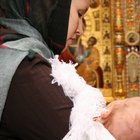
When a Jewish friend or family member dies, observing funeral etiquette helps to properly express sympathy without offending anyone. Gentiles (non-Jews) need to know a few key facts to make this observance as respectful as possible. In Judaism, performing acts of charity, comforting the bereaved and praying on behalf of the deceased are considered good deeds, or mitzvot.
Preparation
Before the body arrives at the funeral, a pious custom is to read Psalms over the body of the deceased. Members of the Jewish community prepare, wash and pray over the body. It then is dressed in a white, shroudlike garment and placed into a simple wood casket. Jewish custom discourages elaborate preparation of the body. A Jewish man often is buried wearing a tallis, or prayer shawl. Jewish funerals take place within 48 hours after the person's death when possible. Therefore, mourners may need to make last-minute travel arrangements. Do not send flowers to the funeral home or synagogue/temple.
At the Funeral
Dress in a respectful manner, in dark colors. A man should wear a suit, and a woman should wear a dress or skirt. Some synagogues require women to cover their hair or men to wear a skullcap (yarmulke), which are available at the entrance. Unlike Roman-Catholic and Orthodox-Christian rites, Jewish funerals are closed casket. They take place at a funeral home, temple or synagogue, and include special prayers and eulogies by a rabbi and family members. Follow the directions of the funeral-home director or the synagogue usher. Sign the guestbook, take your seat and speak quietly. If you are comfortable doing so, you may participate in the prayer service by standing up or responding to the prayers that are read or chanted.
At the Burial
The burial service takes place directly after the funeral. Close family members and friends follow the hearse in a long procession. At the cemetery, they accompany the deceased as the rabbi or officiants recite prayers and the coffin is lowered into the ground. The attendees participate in the burial by taking turns shoveling dirt into the open grave, often three times. This is considered a mitzvot, or good deed, to help the deceased move on. The officiant will give the cue for when to begin. After finishing, replace the shovel into the dirt pile.
Sitting Shiva
Customarily, Jewish mourners sit shiva at the home. "Sitting shiva" refers to a seven-day period for receiving visitors. When visiting, be quiet and respectful. Share memories or anecdotes about the deceased person if you knew him well. It is a thoughtful gesture to bring food to the home so the mourners do not have to cook at such a difficult time. If the family keeps kosher, make sure to bring appropriate food items. Do not bring flowers. It is traditional for the family to rend their clothing or wear a torn piece of black ribbon on their lapel as a symbol of grief.
Following Up
Send a sympathy letter after the funeral, especially if you were unable to attend. The family may have named a special charity for making donations in memory of the deceased. Alternatively, give to a charity of your choice and enclose a card stating this with the sympathy note. Another meaningful gift is to donate a special prayerbook or money to the deceased person's synagogue in her name. When visiting the graveside, place a small stone on the site as a token of your presence. The gravestone is erected one year after the burial in a special ceremony called an unveiling. You may be invited to attend the unveiling with other friends and family of the deceased, and perhaps share afterward in a memorial meal.
Related Articles

How to Dress for a Bris Ceremony

Dress Etiquette for Jewish Funerals

The Common Procedures of a Catholic ...

What Happens at Hindu Funeral Services ...

What Is the Proper Thing to Do With ...

Christian Vs. Hindu Funeral

What Does the Corsage Symbolize?

Role of a Godmother During a ...

Jewish Baby-Naming Ceremony Etiquette

What Is Proper to Send to a Family ...

How to Wear an Arabic Headdress

How to Use a Veil & Cord in a Wedding

What Is the Traditional Dress Color for ...

How to Memorialize on a Death ...

What Can You Wear for a Hindu ...

The Proper Attire for a Girl's First ...

What to Wear to a Baptist Funeral on ...

Gifts for an Indian Engagement

The Purpose of Christening

Greek Orthodox Funeral Traditions
References
Writer Bio
Lisa Smith has been an editor and writer since 1991. Her articles have appeared in "Newton Magazine" and she has contributed to myriad popular books, including "Masters of Deception" and "Click: The Ultimate Photography Guide for Generation Now." She earned her B.A. in semiotics from Brown University and completed coursework for an M.A. in history at New Mexico State University.
Photo Credits
Comstock/Comstock/Getty Images